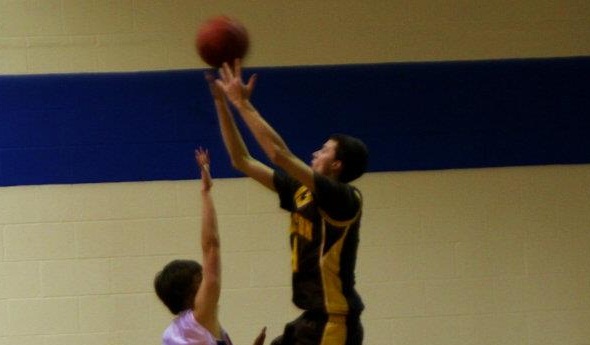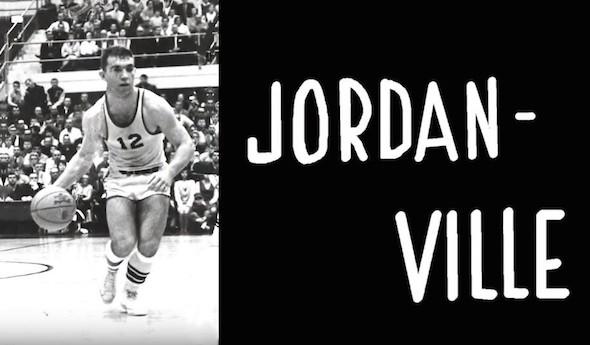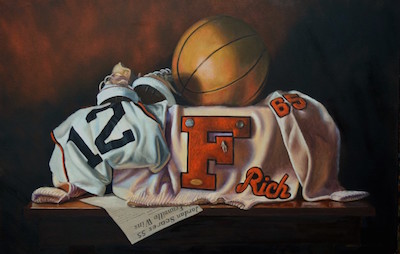
2,241 Reasons to Watch Chris Hass
February 14, 2012
Chris Hass began his freshman basketball season with his sights set on breaking an MHSAA career record.
But if you’ve heard at all of the Pellston High standout, it’s probably not the record you’d think.
Hass is one of just 34 players in MHSAA history to score at least 2,000 points. Only nine players have scored more than his 2,241 points heading into Wednesday’s game against Bellaire.
That record he wanted to break? Career assists, of course. And Hass has a bunch of those too. But the 6-foot-5 senior clearly is known for scoring in bunches few in MHSAA history have equaled.
“For me, it wasn’t something where it was my goal. I definitely feel honored to play on a team that’s willing to give me an opportunity to do that,” Hass said. “I guess it’s a big deal in northern Michigan, getting our name out there. Pellston is a small school, and to hit 2,000 points, it’s starting to get Pellston on the map, which is what the community deserves.”
Hass earned one of this week’s MHSAA High 5s not just for the ridiculous numbers he’s put up this season and over the last four, but for how he’s led the Class D Hornets into at least a glimmer of the state spotlight.
Pellston is 14-1 and can avenge its lone loss tonight against Bellaire, which beat the Hornets 75-58 on Jan. 17. Bellaire is ranked No. 1 and Pellston No. 3 in this week’s Associated Press Class D state poll.
Hass has a history with Bellaire – he scored 26 points in the fourth quarter alone before fouling out in a loss last season to Eagles. That’s the fourth-most points scored in a quarter in MHSAA history – and just one of the many listings Hass has or will have in the record book after his high school career ends sometime next month.
This season, he’s averaging 30.9 points, 8.5 rebounds, six assists, 4.5 steals and 2.5 blocked shots per game. He’s always been a strong ball-handler and continues to man the point despite an ability to play any position. He’s making 55 percent of his shots from the floor – including an incredible 52-percent success clip from 3-point range (he’s made 40 from beyond the arc).
“On nights when we really don’t need him to (score), he almost disappears into the background a little bit to get his teammates involved,” Cliff Hass said. “It’s really about the team, chemistry. He’s always one of the leaders trying to get chemistry (right). Does he love to have that 57-point night? That’s great, but he’s all about winning.”
So much so that Chris Hass almost committing to play next for Bethel College (Ind.), which has won seven NAIA national championships under its current coach, before settling on Bucknell after falling in love with the program and campus during a visit. There, Hass will join 2011 Petoskey graduate Cory Starkey on a team that made the NCAA Tournament last season.
"First and foremost, Chris is just a terrific scorer," said Bucknell coach Dave Paulsen in his program’s early-signing day press release. "He is an excellent shooter with great range, but he is also athletic and `bouncy' and can get to the rim. We expect that Chris will be able to give us a real explosive offensive presence from the perimeter."
Hass’ point total is exactly 600 short of the MHSAA record set by Mio’s Jay Smith from 1976-79. It’s unlikely Hass will break that record – he’d have to average 50 points a game through the MHSAA Final just to tie it – but being in the conversation is something special in itself.
Filling it up is nothing new in the Hass family. Older sister Stephanie Hass held the MHSAA girls scoring record with 2,732 points for a decade until Central Lake’s Jasmine Hines broke it last season. Hass, who played high school at Harbor Springs Harbor Light Christian – and then at Saginaw Valley State University – finished with a career scoring average of 31.4 points per game, tops in the record book.
And she never took it easy on her little brother.
Chris Hass remembered once, when he was 8 or so, getting so angry during a game of one-on-one that he started throwing rocks at his sister. But he also watched and emulated how she worked to improve her game. And around 12 years old, he beat her one-on-one for the first time.
“I do see similarities in both, offensively; ball-handling was probably their number one attribute. It’s the first thing I really noticed,” said Cliff Hass, their father and also Pellston’s boys varsity coach. “(And) they both developed that mentality of being able to score at any time.
“I tell all the players I coach, if you touch the ball 94 feet away (from the basket), your first goal is to score from 94 feet away. Being in the mentality of looking to score, you put pressure on the defense, and they have to stop you. And they might need a second person to try to stop you. “
Chris echoes his dad’s philosophy. But he wanted to make sure people saw him as more than a scorer. At Harbor Light in sixth and seventh grade, he’d been mostly a distributor passing to Collin Hewitt, who now plays at Spring Arbor. But Hass switched to his dad’s school for ninth grade, and began switching roles as well.
He still tries to get as many assists as he can. But although Pellston has other scorers (senior Andy Hamlin tallied his 1,000th career point this season), Hass knows for the Hornets to continue this run – and get a chance to show what they can do against competition from further down state – he needs to keep putting up the points.
“When you say you’re from the Petoskey area, people have no idea where that is,” Hass said. “Knowing we finally maybe might get some respect, I’m definitely excited about it.”

Film Fills In Picture of 'Fennville Flash'
By
Ron Pesch
MHSAA historian
December 28, 2017
We’ve been here before, but not in this way.
The last time was for a retrospective, covering one of the most impressive and awe-inspiring prep careers in Michigan high school history. That time was in print, and included a handful of still images that tried to illustrate the unbelievable.
But this time, the story is in documentary form. It’s woven together from grainy, scratched, faded silent film, a format of capturing memories familiar to thousands of people from generations past, as well as a series of modern-day high-resolution interviews.
Here, the basketball life of the athlete known as the “Fennville Flash” delivers on many levels. Yes, there is a Richie Jordan.
JordanVille, a documentary by John Mooy & Anne Colton, recalls a time when legend spread via word of mouth, newsprint and AM radio.
While it’s hard to comprehend for many today, the exploits of our athletic heroes were formed by “poets in the press box” who sat with pencil and paper, a typewriter, a microphone or a telephone, and described to their audience what they witnessed. On the receiving end, readers and listeners conjured up visualizations based on the facts, phrases and superlatives designed to create an image.
“Traveling left to right on your radio dial” helped listeners feel they were a member of the crowd, seated in the stands, in on the action and a witness to the mayhem. “Packed to the rafters,” reminded fans the importance of what was happening. An exciting game, presented by those with skill, created an event you longed to see. If a broadcast couldn’t be picked up on a transistor or tube radio, the final result might not be known, at the earliest, until the following day’s newspaper arrived.
I’ve told Jordan’s story via the MHSAA before; how he latched on to athletic training, weights and repetition to mold himself into a well-rounded athlete, able to leap to heights unexpected for a kid with a 5-foot-7 frame. The tales of his unfathomable accomplishments slowly leaked beyond the city limits of Fennville into Kalamazoo and greater Southwestern Michigan, then to Detroit. When Detroit Free Press writer Hal Schram relayed Jordan’s feats, the secret traveled across the state and beyond its drawn borders.
From there the legend of Jordan’s accomplishments grew. In Fennville, as in many small towns across the country, the city shut down when a game was played. The Jordan story was so enticing that thousands would travel vast distances to see him play with their own eyes. Today, his single season scoring average of 44.4 points per game during the 1964-65 campaign still remains the top mark in the MHSAA record book.
 JordanVille runs just shy of a half hour. Contained within is insight into the athlete that is challenging to relay in print form. Thanks to access to home movies and a series of interviews with Jordan, former teammates, past opponents and his high school coach, the determination, dedication and drive of a kid who wouldn’t let physical size be a deterrent from achievement radiates from the screen. On display is small town America at its finest, and perspective formed over 50+ years.
JordanVille runs just shy of a half hour. Contained within is insight into the athlete that is challenging to relay in print form. Thanks to access to home movies and a series of interviews with Jordan, former teammates, past opponents and his high school coach, the determination, dedication and drive of a kid who wouldn’t let physical size be a deterrent from achievement radiates from the screen. On display is small town America at its finest, and perspective formed over 50+ years.
For Mooy, it completes a filmmaking journey started six years ago. But the story of Jordan, in his eyes, date back to his school days. Mooy first heard about Jordan as a 7th-grader from a math teacher. A second-team all-St. Joseph Valley League selection, Mooy played at Marcellus High School and scrimmaged against Jordan and the Fennville Blackhawks.
He couldn’t believe his eyes.
“Everyone wanted to see this kid play,” said Mooy in 2011. “He was the first high school player I saw sign an autograph.
Today, with the interviews complete, and the film ready for viewing, Mooy sees more than just a sports story:
“With the benefit of years now passed, I look at the Rich Jordan story with a new respect. JordanVille created a place that was welcoming no matter who you were, or what color your skin happened to be. It was the 1960s. Rich was growing up Jewish, the Civil Rights Movement was in full swing, and the Vietnam War was on everyone's mind. And in Fennville, Michigan, from 1961 to 1965, the Jordan high school years, there were lessons beyond sports being learned by everyone that would last a lifetime. The Jordan household, under the guidance of (his parents) Tuffy and Sylvia Jordan, is where the story begins."
The film speaks of a time that has departed. Competition for our attention was less focused; phones hung on walls or sat on tabletops, communities were tighter, the training table featured peanut butter and chocolate milk instead of protein powder. A city could easily be renamed for a day.
The film also reminds us that those days were far from perfect.
If all goes as planned, the public will see the finished product come the flip of the calendar. In West Michigan, JordanVille is scheduled to show on New Year’s Day at 6 p.m. on WGVU, and will repeat on WGVU-Life at 7:30 p.m., Friday, Jan. 5.
Seek it out, and spread the word, just like in days of old.
 Ron Pesch has taken an active role in researching the history of MHSAA events since 1985 and began writing for MHSAA Finals programs in 1986, adding additional features and "flashbacks" in 1992. He inherited the title of MHSAA historian from the late Dick Kishpaugh following the 1993-94 school year, and resides in Muskegon. Contact him at [email protected] with ideas for historical articles.
Ron Pesch has taken an active role in researching the history of MHSAA events since 1985 and began writing for MHSAA Finals programs in 1986, adding additional features and "flashbacks" in 1992. He inherited the title of MHSAA historian from the late Dick Kishpaugh following the 1993-94 school year, and resides in Muskegon. Contact him at [email protected] with ideas for historical articles.
PHOTOS: (Top) Richie Jordan runs Fennville's offense during his thrilling high school career in the 1960s. (Middle) Jordan memorabilia, as captured by Bill Williams.

